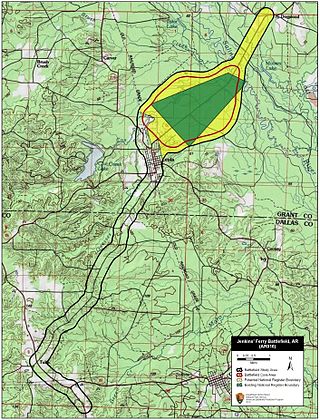
DeValls Bluff is a city in and the county seat of the southern district of Prairie County, Arkansas, United States. The population was 619 at the 2010 census.

The Battle of Jenkins' Ferry, also known as the Engagement at Jenkins' Ferry, was fought on April 30, 1864, at Jenkins' Ferry, southwest of Little Rock, during the American Civil War. Although the battle ended with a Union victory, the Confederates saw it as a strategic success as they claimed to have prevented Frederick Steele from holding southwest Arkansas. Due to the chaotic nature of the battle, casualty figures vary.
The Camden Expedition was the final campaign conducted by the Union Army in Arkansas during the Civil War. The offensive was designed to cooperate with Major-General Nathaniel P. Banks' movement against Shreveport.

The 27th Wisconsin Volunteer Infantry Regiment was an infantry regiment that served in the Union Army during the American Civil War. The regiment began organizing in August 1862 but recruiting problems delayed its entry into federal service until March 1863. Predominantly from the Lake Michigan shore counties of the state, the regiment was mainly composed of German immigrants. The 27th Wisconsin played a supporting role in the Siege of Vicksburg and participated in the capture of Little Rock, Arkansas during the year. The regiment served in the Little Rock garrison and saw its first serious combat in the Camden Expedition of 1864, during which it fought in the Battle of Jenkins' Ferry. The regiment was among the Union forces in the Mobile campaign in early 1865, and was involved in the Battle of Spanish Fort. Ending the war in the occupation of Texas, the regiment was mustered out in August before returning to Wisconsin.

During the American Civil War, Arkansas was a Confederate state, though it had initially voted to remain in the Union. Following the capture of Fort Sumter in April 1861, Abraham Lincoln called for troops from every Union state to put down the rebellion, and Arkansas and several other states seceded. For the rest of the civil war, Arkansas played a major role in controlling the Mississippi River, a major waterway.
The 36th Iowa Infantry Regiment was an infantry regiment that served in the Union Army during the American Civil War.
8th Missouri Cavalry Regiment was a cavalry unit from Missouri that served in the Union Army during the American Civil War. The regiment was formed between 6 August and 15 September 1862. The regiment fought at Prairie Grove and Van Buren in 1862. The unit participated in Frederick Steele's expedition to Little Rock in 1863, fighting at Brownsville, Bayou Meto, and Bayou Fourche. From 1863 to 1865, the regiment remained in Arkansas, going on expeditions to suppress Confederate raiders and other occupation duties. The unit was mustered out of service on 20 July 1865. In January 1863, the regiment committed what has become known as the Huntsville Massacre.
The Choctaw, Oklahoma and Gulf Railroad (CO&G), known informally as the "Choctaw Route," was an American railroad in the states of Arkansas and Oklahoma.

The Battle of Marks' Mills, also known as the Action at Marks’ Mills, was fought in present-day Cleveland County, Arkansas, during the American Civil War. Confederate Brigadier-General James F. Fagan, having made a forced march, attacked a train of several hundred wagons, guarded by a brigade of infantry, 500 cavalry, and a section of light artillery under command of Lieutenant-Colonel Francis M. Drake of the 36th Iowa, on its way from Camden to Pine Bluff for supplies.

Arkansas Heritage Trails System is a network of four historic trails within the state of Arkansas. The heritage trails system was established by the Arkansas General Assembly on March 31, 2009. Roadways included in the system are Arkansas Department of Transportation (ArDOT) as well as county roads. The program emphasizes cooperation among the Arkansas Department of Heritage, the Department of Parks and Tourism, and the Department of Transportation.
The Battle of Bayou Meto, also known as the Battle of Reed's Bridge, was fought near present-day Jacksonville, Arkansas, along the Bayou Meto River, on August 27, 1863. During the American Civil War, Union forces left Helena, Arkansas, to move against the Confederate-held state capital of Little Rock. Part of the Union command, under Brigadier General John W. Davidson, defeated Confederate cavalry commanded by Brigadier General John S. Marmaduke on August 25, in the Battle of Brownsville. After the action at Brownsville, the Confederates fell back to the Bayou Meto. Union attacks on August 27 succeeded in pushing Marmaduke's men back across the bayou, but were unable to break the Confederate line. Davidson withdrew back to Brownsville after the fighting. The Union advance resumed on September 6, and Little Rock surrendered on September 10, after the Battle of Bayou Fourche. Tensions exacaberated during the action at Bayou Meto contributed to the Marmaduke-Walker duel, during which a Confederate general was killed. In 2002, part of the battlefield was listed on the National Register of Historic Places as the Bayou Meto Battlefield.

Eunice is a ghost town on the east bank of the Mississippi River in Chicot County, Arkansas, United States.
The Battle of Brownsville was fought on August 25, 1863, near what is now Lonoke, Arkansas, between Union forces led by Colonel Washington Geiger and Confederate troops under Brigadier General John S. Marmaduke. Union forces commanded by Major General Frederick Steele were advancing from Helena, Arkansas, towards Little Rock, the state capital of Arkansas. Confederate Major General Sterling Price ordered cavalry led by Marmaduke and Brigadier General Lucius M. Walker to Brownsville in response to the Union advance.
The Skirmish at Terre Noire Creek, also known as the Skirmish at Wolf Creek or Skirmish at Antoine, an engagement during the Camden Expedition of the American Civil War, was fought on April 2, 1864. The action occurred about 1 mile (1.6 km) east of Terre Noire Creek along a defile near the towns of Hollywood, Arkansas and Antoine, Arkansas. A Confederate States Army cavalry brigade under Brigadier General Joseph O. Shelby attacked a Union supply train of more than 200 wagons accompanying Union Army Major General Frederick Steele's force which was attempting to reach Shreveport, Louisiana to join with Major General Nathaniel Banks's force in the Red River Campaign with the objective of occupying Shreveport and controlling western Louisiana.

The Battle of Bayou Fourche saw Union forces under the overall command of Frederick Steele clash with Confederate forces led by Sterling Price near Little Rock, Arkansas. The only fighting occurred when Steele's cavalry commanded by John W. Davidson crossed to the south side of the Arkansas River and compelled the Confederate cavalry under John S. Marmaduke to abandon its defensive position behind Bayou Fourche. Price's outnumbered forces evacuated Little Rock and withdrew south to Arkadelphia. The Union occupation of Little Rock was the final action in a campaign that started on August 18 when Steele's troops marched west from DeValls Bluff.

The 16th Texas Cavalry Regiment was a unit of mounted volunteers from Texas that fought in the Confederate States Army during the American Civil War. The regiment was recruited in early 1862 and mustered into Confederate service in April 1862. The unit fought as cavalry at the Battle of Cotton Plant but it was dismounted in the summer of 1862. The 16th Cavalry served as infantry in Walker's Texas Division for the remainder of the war. The regiment fought at Milliken's Bend, Mansfield, Pleasant Hill, and Jenkins' Ferry. The unit marched to Texas in early 1865 and disbanded in May 1865.

The Springfield Illinois Light Artillery, also known as Vaughn's Independent Illinois Battery or Battery A, 3rd Illinois Light Artillery, was an artillery battery from Illinois that served in the Union Army during the American Civil War. Organized in August 1862, the unit was first stationed at Bolivar, Tennessee. In August–September 1863 the battery participated in Frederick Steele's expedition to Little Rock, Arkansas, being engaged at Bayou Fourche. In spring 1864, the battery took part in the Camden Expedition, fighting at Prairie D'Ane and Jenkins' Ferry. The unit sat out the remainder of the war in Little Rock before being mustered out of service in June 1865.
The 13th Missouri Cavalry Regiment was a cavalry unit that served in the Confederate States Army during the American Civil War. In early April 1863, Captain Robert C. Wood, aide-de-camp to Confederate Major General Sterling Price, was detached to form an artillery unit from some of the men of Price's escort. Wood continued recruiting for the unit, which was armed with four Williams guns, and grew to 275 men by the end of September. The next month, the unit fought in the Battle of Pine Bluff, driving back Union Army troops into a barricaded defensive position, from which the Union soldiers could not be dislodged. By November, the unit, which was known as Wood's Missouri Cavalry Battalion, had grown to 400 men but no longer had the Williams guns. In April 1864, Wood's battalion, which was also known as the 14th Missouri Cavalry Battalion, played a minor role in the defeat of a Union foraging party in the Battle of Poison Spring, before spending the summer of 1864 at Princeton, Arkansas. In September, the unit joined Price's Raid into the state of Missouri, but their assault during the Battle of Pilot Knob failed to capture Fort Davidson.
Hopefield was a small community on the Mississippi River in Crittenden County, Arkansas. Its location is near or included within the current limits of the city of West Memphis, Arkansas. It was a ferry crossing point to Memphis, Tennessee, and was served by an east-west rail line built by the Memphis and Little Rock Railroad that eventually became a mainline of the Chicago, Rock Island and Pacific Railway. During the American Civil War General Stephen Hurlbut had the town burned to combat rebel activity. It was rebuilt, hit by a series of Yellow Fever epidemics, and diminished by erosion. Hopefield Chute, an Ox Bow also called Dacus Lake, and Hopefield Lake are in the area, as well as some remains. G. W. Watson moved there.
The Little Rock campaign saw Union forces capture Little Rock, Arkansas during August and September 1863, as part of the American Civil War. Union forces led by Major General Frederick Steele advanced from Helena, Arkansas, beginning on August 10, before joining cavalry commanded by Brigadier General John W. Davidson at Clarendon on August 15. Steele sent Davidson to move against the Confederates, while he pulled his infantry to establish a base at DeValls Bluff. Davidson's men fought with Confederate cavalry commanded by Brigadier Generals Lucius M. Walker and John S. Marmaduke at Brownsville on August 25 and Bayou Meto on August 27 before the Confederates withdrew closer to Little Rock.











